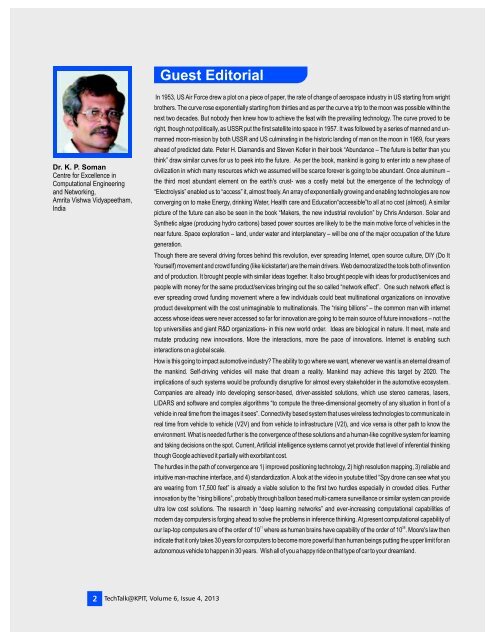Autonomous Vehicles - KPIT
Autonomous Vehicles - KPIT
Autonomous Vehicles - KPIT
You also want an ePaper? Increase the reach of your titles
YUMPU automatically turns print PDFs into web optimized ePapers that Google loves.
Guest Editorial<br />
Dr. K. P. Soman<br />
Centre for Excellence in<br />
Computational Engineering<br />
and Networking,<br />
Amrita Vishwa Vidyapeetham,<br />
India<br />
In 1953, US Air Force drew a plot on a piece of paper, the rate of change of aerospace industry in US starting from wright<br />
brothers. The curve rose exponentially starting from thirties and as per the curve a trip to the moon was possible within the<br />
next two decades. But nobody then knew how to achieve the feat with the prevailing technology. The curve proved to be<br />
right, though not politically, as USSR put the first satellite into space in 1957. It was followed by a series of manned and unmanned<br />
moon-mission by both USSR and US culminating in the historic landing of man on the moon in 1969, four years<br />
ahead of predicted date. Peter H. Diamandis and Steven Kotler in their book “Abundance – The future is better than you<br />
think” draw similar curves for us to peek into the future. As per the book, mankind is going to enter into a new phase of<br />
civilization in which many resources which we assumed will be scarce forever is going to be abundant. Once aluminum –<br />
the third most abundant element on the earth's crust- was a costly metal but the emergence of the technology of<br />
“Electrolysis” enabled us to “access” it, almost freely. An array of exponentially growing and enabling technologies are now<br />
converging on to make Energy, drinking Water, Health care and Education“accessible”to all at no cost (almost). A similar<br />
picture of the future can also be seen in the book “Makers, the new industrial revolution” by Chris Anderson. Solar and<br />
Synthetic algae (producing hydro carbons) based power sources are likely to be the main motive force of vehicles in the<br />
near future. Space exploration – land, under water and interplanetary – will be one of the major occupation of the future<br />
generation.<br />
Though there are several driving forces behind this revolution, ever spreading Internet, open source culture, DIY (Do It<br />
Yourself) movement and crowd funding (like kickstarter) are the main drivers. Web democratized the tools both of invention<br />
and of production. It brought people with similar ideas together. It also brought people with ideas for product/services and<br />
people with money for the same product/services bringing out the so called “network effect”. One such network effect is<br />
ever spreading crowd funding movement where a few individuals could beat multinational organizations on innovative<br />
product development with the cost unimaginable to multinationals. The “rising billions” – the common man with internet<br />
access whose ideas were never accessed so far for innovation are going to be main source of future innovations – not the<br />
top universities and giant R&D organizations- in this new world order. Ideas are biological in nature. It meet, mate and<br />
mutate producing new innovations. More the interactions, more the pace of innovations. Internet is enabling such<br />
interactions on a global scale.<br />
How is this going to impact automotive industry? The ability to go where we want, whenever we want is an eternal dream of<br />
the mankind. Self-driving vehicles will make that dream a reality. Mankind may achieve this target by 2020. The<br />
implications of such systems would be profoundly disruptive for almost every stakeholder in the automotive ecosystem.<br />
Companies are already into developing sensor-based, driver-assisted solutions, which use stereo cameras, lasers,<br />
LIDARS and software and complex algorithms “to compute the three-dimensional geometry of any situation in front of a<br />
vehicle in real time from the images it sees”. Connectivity based system that uses wireless technologies to communicate in<br />
real time from vehicle to vehicle (V2V) and from vehicle to infrastructure (V2I), and vice versa is other path to know the<br />
environment. What is needed further is the convergence of these solutions and a human-like cognitive system for learning<br />
and taking decisions on the spot. Current, Artificial intelligence systems cannot yet provide that level of inferential thinking<br />
though Google achieved it partially with exorbitant cost.<br />
The hurdles in the path of convergence are 1) improved positioning technology, 2) high resolution mapping, 3) reliable and<br />
intuitive man-machine interface, and 4) standardization. A look at the video in youtube titled “Spy drone can see what you<br />
are wearing from 17,500 feet” is already a viable solution to the first two hurdles especially in crowded cities. Further<br />
innovation by the “rising billions”, probably through balloon based multi-camera surveillance or similar system can provide<br />
ultra low cost solutions. The research in “deep learning networks” and ever-increasing computational capabilities of<br />
modern day computers is forging ahead to solve the problems in inference thinking. At present computational capability of<br />
11 26<br />
our lap-top computers are of the order of 10 where as human brains have capability of the order of 10 . Moore's law then<br />
indicate that it only takes 30 years for computers to become more powerful than human beings putting the upper limit for an<br />
autonomous vehicle to happen in 30 years. Wish all of you a happy ride on that type of car to your dreamland.<br />
2 TechTalk@<strong>KPIT</strong>, Volume 6, Issue 4, 2013


